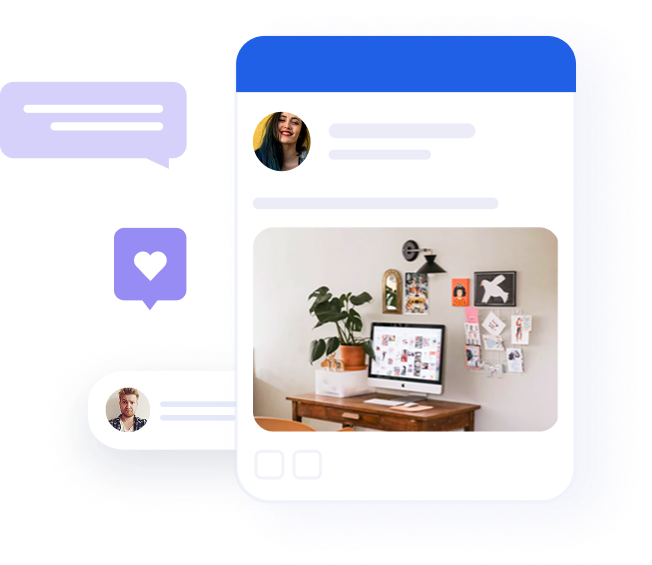
How to generate leads and engagement with social media advertising
Table of contents
While B2B social media marketing comprises free, organic brand evangelism, paid advertising can help you reach a vast portion of your audience and teach them about your brand. Particularly for B2B marketers, the rise of social media advertising demands attention: social ad spending is expected to grow to nearly $14 billion by the year 2018. By judiciously combining paid social campaigns with an already-existing social media marketing strategy, you’ll potentially open the floodgates to interested prospects.
Here, we’ll show you a roadmap for implementing social media advertising alongside your existing social strategy to generate and engage leads.
Determine how you’ll measure success
Before you even start your social media advertising efforts, you have to know how you’re going to track performance. Deciding on which key performance indicators (KPIs) matter ahead of time will allow the most effective ads for your marketing objectives to emerge.
A word of warning: B2B marketers should avoid tracking “vanity metrics,” such as the simple number of Facebook followers and Likes or Twitter Retweets you’ve managed to collect. While such numbers might provide some sense of your brand’s exposure to the market, they are useless for lead qualification.
To really get a sense of what your social media advertising campaign will achieve, you should decide from the outset to focus on very specific KPIs. Here are a few examples to choose from:
- Shares or “Mentions”. The number of shares or mentions your social posts get can tell you how many people are actively seeking to interact with your company. These leads have potential–they are not just passive “followers” of your brand, destined to forget about it later. This engagement will also tell networks like Facebook and LinkedIn that people find your promoted posts valuable, making them more likely to display your content to your followers organically.
- Social Traffic. This tells you, simply, how many visitors to your corporate website are arriving via particular social channels. Compared with the number of visitors who come by other means (search engines, links in email, etc.), this KPI will show you the strength of your overall social lead acquisition and which specific social channels are the most promising.
- Conversion Rate. You’ll get perhaps the best sense of your social media marketing ROI by measuring your conversion rate. Dividing the number of clearly-defined conversions (such as whitepaper downloads, email newsletter subscriptions, or online purchases resulting from calls-to-action) by the number of social leads can give you an immediate sense of your campaign’s efficiency.
Whichever KPIs you choose to track, you’ll have a handle on the most important metrics for refining your social media ads to meet your company’s specific goals.
Take stock of what already works
If you’ve been engaged in organic social media marketing for any length of time, you’ve probably garnered some attention from your target audience. Now, you can use what’s worked to guide your foray into paid social outreach.
Your most popular content pieces shine a spotlight on what will likely attract future prospects. It only makes sense to build on top of success:
- Use your best-performing social content as a template for “native ads”. Since your audience is already used to the style and tone of your LinkedIn company updates and Facebook posts, chances are they will be receptive to native ads on those platforms. 70% of internet users would rather learn about products through content as opposed to traditional ads, and with ads that resemble organic native content, you’re much more likely to engage and convert leads.
- Use your most-downloaded marketing collateral as the offer of your ads. If there’s a certain whitepaper, or report that has noticeably increased your conversion rate and gets enthusiastic reviews from your clients, take it as a hint that such materials would make good offers for your advertisements.
Knowing what has worked well for your audience is a surefire way to begin your social media advertising efforts on the right foot.
Recommended for further reading
Write ads based on the targeting options and analytics offered by each social network
Each social network has its strengths and weaknesses when it comes to targeting. Use the unique offerings of each platform to make informed decisions about the structure of your advertising campaign.
- Facebook stands head and shoulders above the other major social networks in terms of brand evangelism: 58% of Facebook members have “liked” a brand, and 41% have shared a link, video or story about a brand. B2B marketers should thus create a powerful story around their brands with effectively targeted ads. Facebook allows behavioral and interest-based targeting, enabling you to construct rich media ads that showcase your brand’s uniqueness.
- LinkedIn is responsible for 80% of B2B leads, making it a platform that simply can’t be ignored. Data-driven content and other types of marketing collateral that high-level professionals find useful–such as expert opinions expressed in interviews, or in-depth case studies–are good offers for your ads. In addition, LinkedIn’s Showcase Pages let you construct offers that target specific industries, job titles, and other lead attributes.
- On Twitter, ads with images or videos are winners. After targeting prospects by using Twitter’s enhanced Audience Insights, use attention-grabbing visuals that draw leads into your brand’s story. You can also create Twitter Lead Generation cards to add a web form into your Twitter ad.
B2B marketers have more tools at their disposal than ever before to understand their target audience on an intuitive level. Use the gifts given to you by each social platform to create targeted ads that speak directly to your prospects.
Schedule your promotions in a way that seamlessly complements your organic social marketing
Once you draw up a plan for your social advertising campaign, schedule ads to go live alongside organic posts with social media management software. Engage with prospects via social ads just as you would through organic discussion threads that remain locked inside social platforms. Over time, a clear picture will emerge of which ads garner the most engagement, which ones drive positive change in your selected KPIs and what refinements you’ll need to make to bring in even more qualified leads.
There’s a vast number of highly qualified leads you would simply never find without social media advertising. With KPIs of interest and specific insights gained from inbound social marketing in mind, you’ll find that social advertising is indispensable to your lead generation arsenal.
Cover Image via @pixlars




